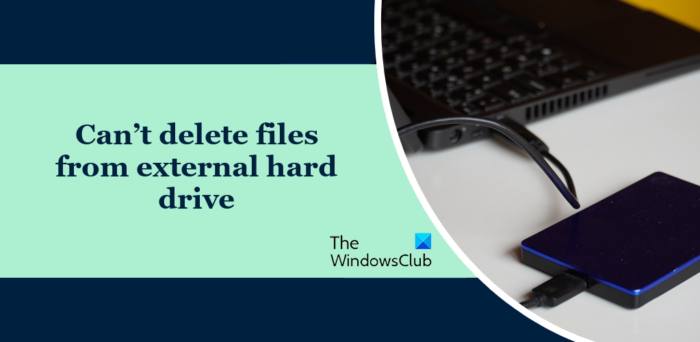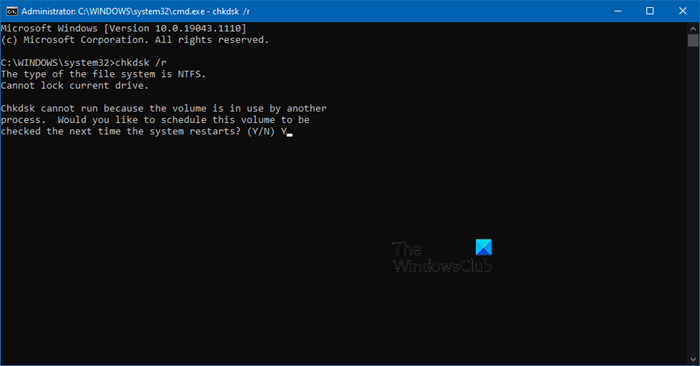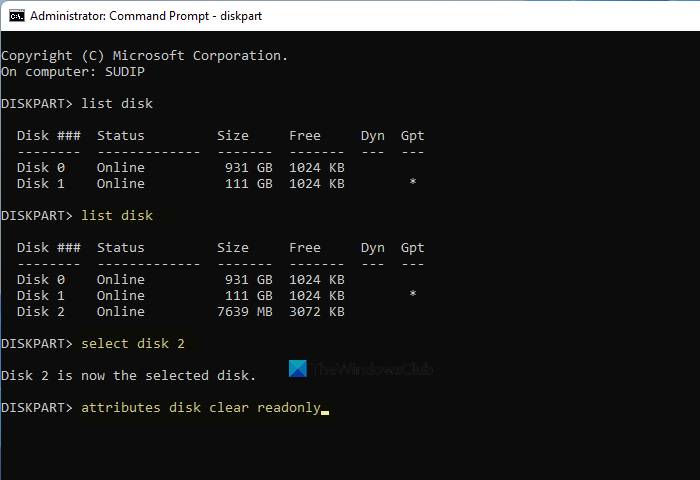Are you unable to delete files from your external hard drive on your Windows computer? If so, this post will help you resolve the issue.

How do I delete files from my external hard drive?
You can easily delete files from your external hard drive. Just open File Explorer, open your external drive, right-click on files and folders you want to erase, and select the Delete option. Or, select all the files and hit the Delete button on your keyboard.
Why can’t I delete from my external hard drive?
There could be various reasons you might be unable to delete files from your external hard drive. One of the common reasons is that the external hard drive is write-protected, which does not let you erase data from the drive. Another common reason is that the hard drive’s file system is corrupted or the drive contains bad sectors, making it difficult to modify files. It could also be permission issues triggering the problem.
Can’t delete files from external hard drive in Windows 11/10
If you are unable to delete some files and folders from your external hard drive, here are the solutions you can apply to fix the issue:
- Make sure the file is not in use by another process.
- Take ownership of the problematic file/folder.
- Run the CHKDSK command.
- Remove write protection on your external drive.
- Connect the hard drive to another computer and check if it helps.
- Format your external hard drive.
- Try using a third-party file deletion software.
Before applying these fixes, try disconnecting your external hard drive and reconnecting it to your PC. Also, try connecting the hard drive to another USB port and see if it helps. If not, proceed with the below solutions.
1] Make sure the file is not in use by another process
The file you cannot delete might be in use by another process. So, ensure the file is not in use and then try deleting it.
See: USB error There is no media in the specified device.
2] Take ownership of the problematic file/folder

This issue might be caused because of permission issues with the target file or folder. So, the first thing you can do is take ownership of the files and folders you cannot delete and see if the issue is fixed. Here are the steps to do that:
First, press Win+E to open File Explorer using Win+E and move to the external drive with which you are experiencing the issue.
Now, right-click on the problematic file/folder, and from the context menu, click on the Properties option.
In the Properties window, navigate to the Security tab and click on the Edit button present below. And then, click on the Add button in the new window.
Next, enter Authenticated Users inside the Enter the object name to select box and press the OK button.
After that, select the Authenticated Users name and then tick the Allow checkbox present next to Full control.
Once done, click on the Apply > OK button to save changes.
You can now try deleting the files from the external drive and check if the problem is resolved.
Read: All my Files and Folders are Read Only on Windows PC.
3] Run the CHKDSK command

If the above method doesn’t work, you can use the Check Disk Utility (CHKDSK) command to repair drive errors. Here’s how:
First, open Command Prompt with administrator privilege using Windows Search; open the taskbar search option, enter cmd in the search box, hover the mouse over the Command Prompt app, and select the Run as administrator option.
Now, enter the below command:
chkdsk C: /f /r
In the above command, the letter C represents the drive letter on which you perform the disk check command. So, replace it with your external hard drive letter.
Once the command is finished, you can try deleting files from your external hard drive and check if the problem is fixed.
Read: External Hard Drive keeps disconnecting in Windows PC.
4] Remove write protection on your external drive

If you are still unable to delete files from your external drive, it might be the case that your external hard drive is write-protected which is why you can’t delete or edit files. If this case applies to you, remove write protection from your external drive and then check if the issue is gone. To do that, you can use the Windows built-in command-line disk management tool called diskpart. Here’s how:
First, open the Command Prompt with admin rights. Now, type the below command and hit the Enter button:
diskpart
Next, enter the below commands one by one:
list disk select disk 2
In the second command, replace 2 with the disk number of your external hard drive.
Now, type the below command to remove write protection from the drive and press Enter:
attributes disk clear readonly
When done, you can check if the issue is fixed.
See: USB 3.0 External Hard Drive not recognized in Windows.
5] Connect the hard drive to another computer and check if it helps
In case the issue persists, you can try connecting your external hard drive to another computer and see if you can clear unwanted files and folders.
Read: Cannot delete items from Recycle Bin in Windows
6] Try using a third-party file deletion software
There might be some stubborn files on your external hard drive that can’t be removed by the normal deletion method. So, in that case, you can use third-party file deletion software to delete unwanted files and folders from drives. There are some good free file deletion software, including Free File Unlocker, Tizer Unlocker, Emco Unlock It, Delete Doctor, Wise Force Deleter, and Unlocker, that you can use.
Read: Fix Unallocated Hard Drive without losing Data in Windows.
8] Format your external hard drive
If nothing else worked, formatting the external hard drive is the last resort. Your hard drive might be corrupted beyond repair, and thus, you cannot modify files. If this scenario is applicable, you can format your external hard drive and then see if it helps.
Do note that formatting the drive will clear all your data stored in it. So, if there are some necessary files that you don’t want to lose, create a backup of them in another drive before you proceed with the formatting process. This is a good solution if you want to clear most of the files. But, use this when the above solutions don’t work.
I hope this post helps!
Now read: External Hard Drive not showing up or detected in Windows.
Leave a Reply